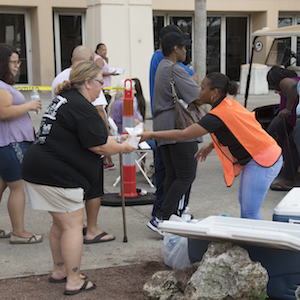 Volunteers pass out supplies such as water, clothing, food, and diapers at a community donation center in Houston following Hurricane Harvey. ©FEMA, 2017.
Volunteers pass out supplies such as water, clothing, food, and diapers at a community donation center in Houston following Hurricane Harvey. ©FEMA, 2017.
By Samantha Montano and Paolo Cavaliere
Four major hurricanes have affected the southern United States and U.S. territories in the past month, throwing many communities into periods of extended disruption. After immediate life-saving needs are met, public officials almost immediately turn their attention to recovery efforts. Ideally, communities would have recovery plans in place before a disaster, but in reality communities often plan for recovery during recovery. When decisions that can have enduring consequences are made in haste, it is all the more important that public officials include public input.
Research shows that highly collaborative planning processes result in better planning outcomes. Public participation is important because it upholds democratic values, which maintain that residents have the right to express their opinions on proposed projects. Having a broad spectrum of stakeholders, planners, and managers involved in solving problems allows knowledge and different views to be incorporated.

A volunteer hands bottled water to a resident at a food distribution center in Lakeland, Florida. ©Patsy Lynch, 2017.
Public officials who are considering a participatory process will benefit from the following information and recommendations, which are informed by research in this area:
What is the purpose and what are the objectives of the participatory process?
Agencies should clarify the goal of the participatory recovery and the objectives should be collectively agreed upon with various stakeholders. It is important for local communities to make their own decisions about recovery priorities, how to fund recovery projects, and which mitigation strategies they may want to implement. This helps a community to feel ownership over the process and ensures that the decisions that are made reflect the values of the community.
Who should be involved in a participatory process?
Communities are made up of a variety of stakeholders (i.e., residents, businesses, nonprofits, government officials) with various perspectives and priorities. These stakeholders might be interested in various aspects of the recovery process that affect them or their constituents. Public officials should consider making the participatory process representative of the entire community, paying special attention to making the process accessible for all members.
When is the right time for planning the participatory process?
If public officials have not engaged in recovery planning before the disaster, they now have a chance to implement a participatory process post-disaster. Keeping in mind time constraints, administrators can arrange public meetings as soon as the emergency response has ended. This allows leaders to identify interested parties and begin to create a culture of community participation from the very start of recovery.
What techniques can be used to encourage the participatory process?
The various issues during recovery should be presented and discussed openly to allow residents to offer comments, question the feasibility of projects, and integrate their thoughts and preferences. Communities have found advisory committees and collaborative planning are efficient models. With the first, the public can give comments on plans, through the second, residents are given significant roles in decision making. Regardless of specific techniques, a two-way communication approach between public officials and stakeholder groups are important.
Avoiding some pitfalls.
Designing a participatory process is not an easy task and there are some pitfalls public officials will want to avoid. If administrators do not have an effective communication approach, they risk not reaching all the interested parties. It is critical to clearly explain why stakeholders will be interested in the process, otherwise participatory recovery won’t receive public attention.
Tapping into the collective knowledge of residents is essential. If residents feel that their knowledge is not valued, they might also avoid engaging in the process. Failure to include the public can result in conflicts after decisions are made. Finally, it is important to not wait too long to begin the participatory process or the effort risks losing credibility and the trust of constituents.
Understanding that stakeholders across the community engage in recovery efforts outside the leadership of public officials can be useful. Maintaining a working relationship between stakeholder groups can encourage collaboration, while removing bureaucratic barriers can allow community groups and businesses to quickly address recovery needs.
Overall, designing a participatory recovery process provides an opportunity for a more successful community recovery. Public officials can expand their understanding of community problems and needs by assembling a broad coalition of stakeholders. Including the public decreases the chances of facing opposition after the process is underway. It is also an opportunity to educate the public about hazards and disasters. Ultimately, the recovery process can be more effective, efficient, and equitable when public officials engage in a participatory process.
